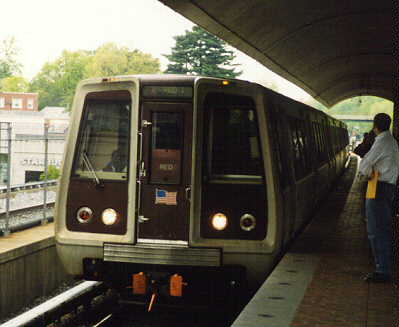
On April 29, 1999 armed with several rolls of high speed film, my friend Paul and I headed to explore the Washington, DC Metro. The Washington Metro consists of five different lines designated by colors: Red, Blue, Green, Orange and Yellow. Each line extends from the suburbs and dips into the city center. We started at the Silver Spring, MD station of the Red Line. For many years, the Red line ended at Silver Spring, but recently it was extended several miles further north.
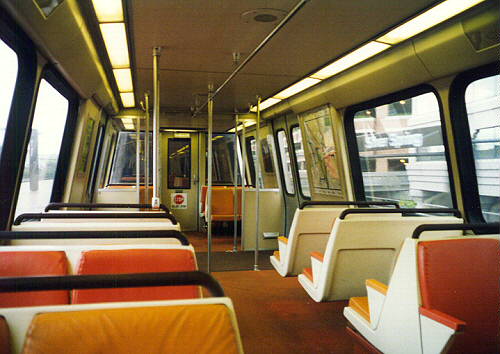
This was the view from inside the car as we left the Silver Spring station. Two manufacturers built all the cars: Rohr and Breda. I'm not yet familiar enough with the two types to be able to distinguish them, but I've been told all the Metro photos on this page are of Breda built equipment. The cars are kept reasonably clean, and the picture shows two creature comforts some other subways (such as NYC) have been unable to sustain: padded seats and carpeting.
For many miles, this segment of the Red line parallels the right of way first used by the B&O in 1871 for their route from Washington to Frederick, MD. Eventually, it diverges and dips underground as it approaches Union Station. We were headed for Gallery Place.

The photo of Gallery Place/Chinatown at right shows the typical architecture of most underground Metro stations. The honeycombed walls and ceilings, and indirect lighting are pleasantly surprising the first time you see them. After a while, though, all the stations start looking the same.

Taking good photos in the poorly lit cavernous stations was a real challenge. The image above is one of the best; about half came out too dark. The Nikon camera I was using is fully automatic (it selects both aperture and shutter speed). After seeing the results, I realize I should have "bracketed" the photos by manually overiding the settings. I used both 800 and 1000 speed film, and oddly, the shots with slower 800 film (such as the one above) were better. To the left is an example of the disappointing, grainy results from the 1000 speed film. That's a Blue line train entering L'Enfant Plaza.
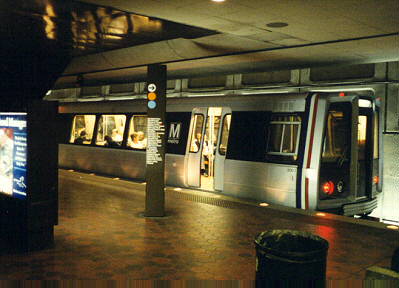
Not all the 1000 speed film photos came out poorly. Here's a side view just as the doors were closing.
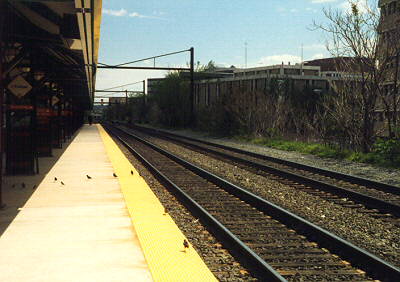
The day was sunny and cool, so we decided to emerge from the subterranean world and walk to Union Station. On the way, we stopped at the L'Enfant Plaza station of the Virginia Railway Express (VRE). The VRE is the main commuter rail line to/from Washington's southern suburbs. The trains run only during the morning and evening rush. This photo was taken about 1pm, when only birds and panhandlers were to be found in the vicinity. Here at L'Enfant Plaza the VRE uses the old Pennsylvania Railroad line south to the former Potomac Yards.

This is Union Station, not long ago restored to its original glory. Fortunately, the grand structure was recognized for its place in history before it could be demolished and replaced. This was where the Pennsylvania Railroad, Baltimore and Ohio Railroad and Southern Railway met to exchange passengers in the heyday of rail travel. These days, it remains an important station for train travel.
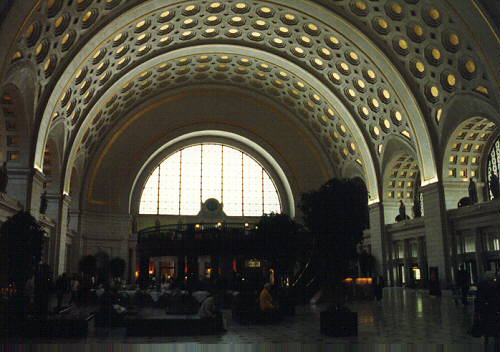
This is the view inside Union Station. The main entrance seen in the photo above is on the right side in this shot. Ticketing and trains are to the left. I wonder if the honeycomb ceiling design found here was the inspiration for that in the Metro stations...

Awaiting in the bowels of Union Station for homeward bound, weary commuters are several MARC trains parked nose to tail. This is MARC locomotive 57 pointing the way to the suburbs in Maryland.
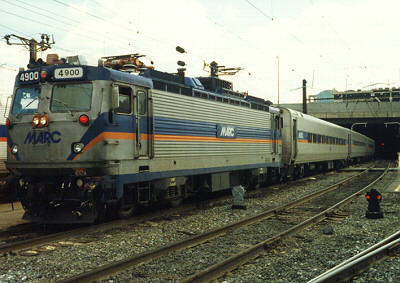
Here's another MARC train, parked just a bit further down the platform.
Next, we ate a late lunch at the huge food court in the station, and stopped in a train store (which had a great selection of books, with astronomical prices...$65 for a 64 page paperback? Get real.). Then it was back on the Metro to return to Silver Spring.
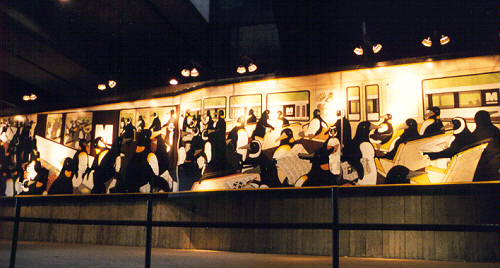
Here we are arriving back at the Silver Spring Metro station along with many other commuters just as the evening rush is beginning. We're the ones not wearing suits.
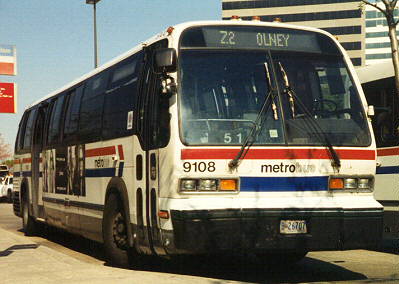
The Silver Spring station sits near the intersection of Georgia Avenue and US Rt. 29 (live camera image), both important commuter routes to the Maryland suburbs in Montgomery and Howard counties. Countless busses await Metro passengers to escort them on the next leg of their trip home.
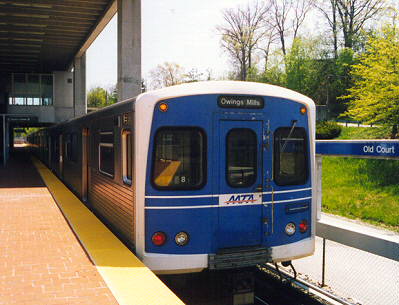
Even though its network of automobile highways is poorly interconnected, Washington does not have a monopoly on commuting. Baltimore has a subway system too, though at the current time it's more of a subway line...one to be exact. The line runs from Owings Mills (northwest of the city) to The Johns Hopkins Hospital downtown. The trains look somewhat boxy, and, while in operation, sound very much like those of Washington's Metro.
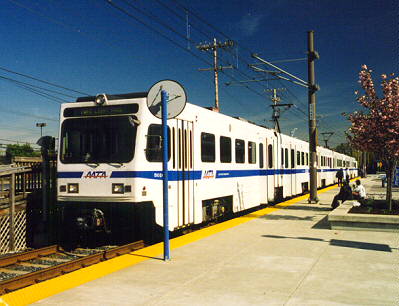
Perhaps more useful because it covers more territory is Baltimore's Light Rail system. The system connects BWI airport with downtown, and extends well north of the city. Fare collection operates on an honor system: you are expected to purchase a ticket before boarding, but there is no turnstile or ticket taker. Only spot checks are made, and if you are found without a ticket, there is a steep fine. The photo at left was taken at the Cromwell station, the southern terminus of the system.
This portion of the light rail operates along the old right of way established by the Baltimore and Annapolis Railroad in 1887.
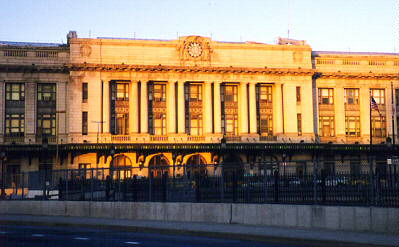
The light rail, plus all Amtrak Northeast corridor trains, stop at Baltimore's Penn Station. Probably because the Pennsy was not the first major carrier in Baltimore (the B&O was), its station is not located downtown...instead it's about a mile north. The exterior is more impressive looking than the interior.
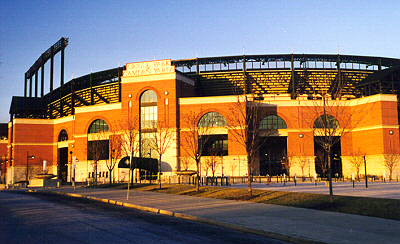
Except for light rail service, the B&O's Camden Station in Baltimore is no longer in use as a transportation facility. Instead, it has been taken over by the birds, the Orioles baseball team to be specific. In this view you cannot see the original B&O warehouses located behind the stadium; they are now in use as offices. (These last two photos were taken in February 1999.)
Return to main photo project page
Comments? Corrections? EMail intersys@insystem.com
All text and images on this page are Copyright 1999 by Intersystem Concepts, Inc. Permission is granted to copy and reuse the text and images from this page provided 1) no fee is charged, 2) our original copyright is preserved, and 3) we are credited as the source (please include a link back to this page).